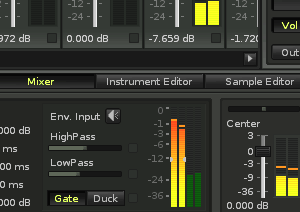

Double click on a song to load it, then press play to see and hear Renoise in action. Upon first loading Renoise you will see a list of demo songs here. From here you can start/stop the song and access basic editing features such as Edit Mode (record) and the metronome.īelow the Transport Panel are the Scopes, which provide visual feedback and can help you to analyse the song as it is playing.Īt the bottom right corner of the interface is the Disk Browser, which is used to load or save songs, instruments, samples, effect chains etc. Just below the Upper Status Bar on the left-hand side are the basic Transport Panel controls. Further right is the VU meter showing the current Master volume level, followed by the MIDI controls ( MIDI Mapping button, MIDI I/O LEDs), Song Timer and the current CPU usage. Next is the button to enable auto-adjusting of the Master volume level to avoid clipping (the volume will be automatically lowered when clipping occurs). The left side offers a variety of menu options and just to the right of this is the Master volume slider, which controls the overall volume of the song. Located at the very top of the interface is the Upper Status Bar. Note the links in blue, which you can click on for more detailed information about the various components. We will now briefly go through the main areas of the Renoise interface. Looking at how these songs play can be a great way to learn about how Renoise works, so just double click on one to load it in and hit the Play button at the top-left or press the space-bar on your computer keyboard. There are also tabs which show the files that have been recently loaded and saved, as well as quick access to the demo and tutorial songs.
The panel provides links to this manual, the user forum and the official website. You should also see the Welcome panel, but if you've disabled or dismissed it, just click on the Renoise logo at the bottom-right corner to bring it back. When you launch Renoise for the first time you will be presented with something similar to the image below:
#Renoise output bitrate manual#
If you haven't already set up audio and MIDI devices, then it's recommended to move on to those sections of the manual after reading through this page. This means the interface may look unusual or a bit complex, but this introduction will familiarise you with its main components and explain their basic functions. Welcome to Renoise, an audio creation package that is significantly different from most of the others. 1.3 Renoise Work-flow: Learning the Keys.1.2 Guide Yourself Through the Interface: Tooltips.and will be integrated in other platforms in the coming weeks. This enhanced algorithm is already available in Linphone-android 3.3. You can learn more about how does adaptive bitrate algorithm work on our Wiki. Our algorithm operates by doing at receiver side some statistical analysis of timings of arrivals of audio & video packets, and send target bitrate commands to the remote audio and video encoders.

Detect the bandwidth capacity available, so that the output bitrate of the encoder can be increased dynamically up to this capacity in order to offer the best possible audio and video experience to the users.Detect network congestion, so that the output bitrate of the encoder can quickly be reduced, which allows to recover an optimal latency and stop video artefacts caused by packet losses.The two objectives of our brand new adaptive bitrate algorithm are then to : When the network bandwidth is not sufficient, the streams will be received damaged, with variable delay and loss of data. However, the available bandwidth is not something known in advance by the applications, and it can vary during the call, for example it depends on network usage made by other apps and signal strength of wireless networks. It is then important that the encoding quality is chosen in such a way that the resulting output bitrate is compatible with the network bandwidth capacity available between the participants of a call. A high quality video stream will always request more bitrate, and then more network bandwidth than a low-quality video stream. Linphone has now a brand-new algorithm to adapt the audio and video codec bitrates to the available bandwidth, and hence optimize audio and video quality.ĭuring a call, the audio and video quality mostly depends on the encoder's output bitrate.


 0 kommentar(er)
0 kommentar(er)
